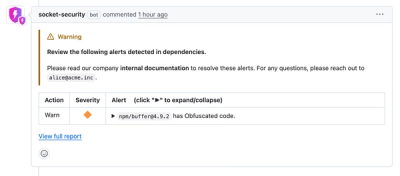
Security News
Crates.io Users Targeted by Phishing Emails
The Rust Security Response WG is warning of phishing emails from rustfoundation.dev targeting crates.io users.
$ pip install drf-keycloak-auth
Add the application to your project's INSTALLED_APPS in settings.py.
INSTALLED_APPS = [
...
'drf_keycloak_auth',
]
In your project's settings.py, add this to the REST_FRAMEWORK configuration.
Note that if you want to retain access to the browsable API,
then you will want KeycloakSessionAuthentication too.
REST_FRAMEWORK = {
...
'DEFAULT_AUTHENTICATION_CLASSES': [
...
'drf_keycloak_auth.authentication.KeycloakSessionAuthentication',
'drf_keycloak_auth.authentication.KeycloakAuthentication',
]
}
The drf_keycloak_auth application comes with the following settings as default,
which can be overridden in your project's settings.py file. Make sure to nest them within DRF_KEYCLOAK_AUTH as below:
# should be comma separated string
KEYCLOAK_ROLES_TO_DJANGO_IS_STAFF = \
os.getenv('KEYCLOAK_ROLES_TO_DJANGO_IS_STAFF')
DEFAULTS = {
'KEYCLOAK_SERVER_URL': os.getenv('KEYCLOAK_SERVER_URL'),
'KEYCLOAK_REALM': os.getenv('KEYCLOAK_REALM'),
'KEYCLOAK_CLIENT_ID': os.getenv('KEYCLOAK_CLIENT_ID'),
'KEYCLOAK_CLIENT_SECRET_KEY': os.getenv('KEYCLOAK_CLIENT_SECRET_KEY'),
'KEYCLOAK_VERIFY_SSL': os.getenv('KEYCLOAK_VERIFY_SSL', True),
'KEYCLOAK_AUTH_HEADER_PREFIX':
os.getenv('KEYCLOAK_AUTH_HEADER_PREFIX', 'Bearer'),
'KEYCLOAK_ROLE_SET_PREFIX':
os.getenv('KEYCLOAK_ROLE_SET_PREFIX', 'role:'),
'KEYCLOAK_MANAGE_LOCAL_USER':
os.getenv('KEYCLOAK_MANAGE_LOCAL_USER', True),
'KEYCLOAK_MANAGE_LOCAL_GROUPS':
os.getenv('KEYCLOAK_MANAGE_LOCAL_GROUPS', False),
'KEYCLOAK_DJANGO_USER_UUID_FIELD':
os.getenv('KEYCLOAK_DJANGO_USER_UUID_FIELD', 'pk'),
'KEYCLOAK_FIELD_AS_DJANGO_USERNAME':
os.getenv('KEYCLOAK_FIELD_AS_DJANGO_USERNAME', 'preferred_username'),
'KEYCLOAK_ROLES_TO_DJANGO_IS_STAFF': (
[x.strip() for x in KEYCLOAK_ROLES_TO_DJANGO_IS_STAFF.split(',')]
if KEYCLOAK_ROLES_TO_DJANGO_IS_STAFF
else ['admin'] # can be list, tuple or set
)
}
All you need to do now is have your client code handle the Keycloak authentication flow,
retrieve the access_token for the user, and then use the access_token for the user
in an Authorization header in requests to your API.
Bearer <token>
Roles will be present in request.roles with a KEYCLOAK_ROLE_SET_PREFIX prefix
(only if succesfully authenticated), e.g.:
['role:admin', 'a4a9be6e-bd04-42f8-9377-27d9db82216f']
except for the authenticated user's pk field, e.g. for a user model using uuid's as primary key:
['role:user', 'a4a9be6e-bd04-42f8-9377-27d9db82216f']
where the pk can be used for checking object ownership.
If you wish to create your own role permissions:
https://www.django-rest-framework.org/api-guide/permissions/#custom-permissions
simply import and use the prefix helper:
from .keycloak import prefix_role
ROLE_USER = prefix_role('user')
ROLE_SERVICE = prefix_role('service')
ROLE_ADMIN = prefix_role('admin')
request.user.is_staff will be modified based upon roles in KEYCLOAK_ROLES_TO_DJANGO_IS_STAFF.
These roles can be hard coded as a list, tuple or set, or from a comma-separated env var.
Functionality ignored if KEYCLOAK_ROLES_TO_DJANGO_IS_STAFF is None or empty.
If your user model doesn't / can't have a UUID primary key, override the
KEYCLOAK_DJANGO_USER_UUID_FIELD setting to indicate a unique UUIDField on your model, e.g.:
KEYCLOAK_DJANGO_USER_UUID_FIELD = 'uuid'
Voila!
An application can be configured for multiple sites by using different
Keycloak Realms on the same or seperate Keycloak instances by using the environment var KEYCLOAK_MULTI_OIDC_JSON
The client OIDC adaptor json file can be downloaded from Keycloak.
KEYCLOAK_MULTI_OIDC_JSON:
{
"auth.example.org": {
"realm": "example",
"auth-server-url": "https://auth.example.org/auth/",
"ssl-required": "external",
"resource": "my-client",
"verify-token-audience": true,
"credentials": {
"secret": "my-secret"
}
}
}
KeycloakMultiAuthentication should be configured as the authentication class.
REST_FRAMEWORK = {
...
'DEFAULT_AUTHENTICATION_CLASSES': [
...
'drf_keycloak_auth.authentication.KeycloakMultiAuthentication',
]
}
NOTE: This will ignore DEFAULTS parameters for hostname, realm and client credentials.
All other parameters are still shared accross sites.
This library includes KeycloakSessionAuthentication for using the
Standard flow Keycloak login to interact directly with a browsable API.
Requires 'Standard flow' to be enabled in the Keycloak client and a valid redirect URL to be configured.
settings.py:
'DEFAULT_AUTHENTICATION_CLASSES': [
'drf_keycloak_auth.authentication.KeycloakSessionAuthentication',
]
urls.py:
urlpatterns = [
path('api-auth/', include('drf_keycloak_auth.urls', namespace='rest_framework'))
]
FAQs
A convenience libary for authenticating users from Keycloak access tokens
We found that drf-keycloak-auth demonstrated a healthy version release cadence and project activity because the last version was released less than a year ago. It has 2 open source maintainers collaborating on the project.
Did you know?

Socket for GitHub automatically highlights issues in each pull request and monitors the health of all your open source dependencies. Discover the contents of your packages and block harmful activity before you install or update your dependencies.

Security News
The Rust Security Response WG is warning of phishing emails from rustfoundation.dev targeting crates.io users.

Product
Socket now lets you customize pull request alert headers, helping security teams share clear guidance right in PRs to speed reviews and reduce back-and-forth.

Product
Socket's Rust support is moving to Beta: all users can scan Cargo projects and generate SBOMs, including Cargo.toml-only crates, with Rust-aware supply chain checks.